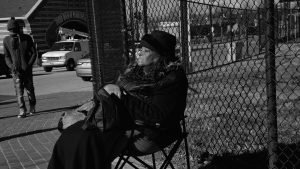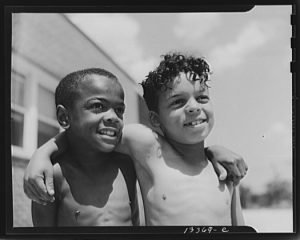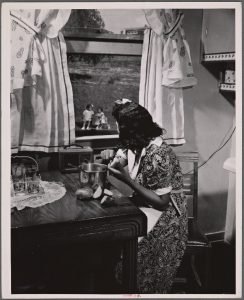By Katie Davis
Around Washington people say Anacostia as a code word for poverty, crime, isolation. Many add in a low voice, “Don’t go there.” In fact, a city-wide website left it off the map entirely and pushed Virginia up into D.C..

I say, go to Anacostia in South East Washington while it is still a mostly black neighborhood with a rich history. Cross the Anacostia River, not something most white Washingtonians (including me) have often done. Walk along Martin Luther King Avenue and see the life sized posters pasted onto the walls, a kind of guerilla art project against gentrification and unwanted change. The neighborhood celebrates locally driven start-ups like The Turning Natural Juice Bar which recently had its ribbon-cutting, and the new cafe in the Anacostia Arts Center. Small business owners cluster in the basement incubator called The Hive 2.0.
When I started this project, the goal was to introduce the neighborhood and its people. It’s grown into much more.

I was given the name of the playwright John Johnson. I went to see him at his home in a cul-de-sac up Morris Road. After some conversation, he stood, strapped his 1-year-old daughter onto his chest and said, “Let’s take a walk.” We went up a steep hill and then over to an enormous church surrounded by open land.
“Turn around,” John said. And when I did, there was Washington laid out like a post card. I’d never seen the city from the east side of the river; no buildings blocking the view, just a blue sky and the sandstone Capitol, the granite and marble Washington Monument.
“This is what we have,” said John. “This is what they want.”
Those words led to many stories. Stories about what it feels like to live in an area rich with history that is being eyed by developers. The stories seemed to take charge and tell themselves.
My strategy was to get out of the way, an unusual tactic for a producer.
I gave digital recorders to John, Kymone Freeman and Schyla Pondexter-Moore, producers who live and work in the neighborhood. Within a month, they started sharing recordings of conversations that were intimate and vibrant and without a filter.

One of John’s neighbors talked about her Aunt Helen. “She’d sit in her window all day, watching everything and everybody. She’d say, “Hey. Whatcha doing? And she had a pad of paper by her, with her neighbors’ numbers. And she’d get on that rotary phone and call, if she saw anyone playing hooky, she’d call their parents.”
What I am learning is that Anacostia, while facing big changes is struggling to protect the creativity and strength that is taken for granted by its residents. People are tracking the change and taking actions to control it. The stories we’ve collected show that place matters; its scale and the unspoken rules shape its boundaries. And this is the map we need to follow.
Katie Davis is a longtime independent broadcast journalist based in Washington, D.C. She has been a producer, host and reporter for National Public Radio and a contributor to This American Life. Anacostia Unmapped is a national project of Localore from the Association of Independents in Radio. Funding comes from the Corporation of Public Broadcasting. If you have any stories to add, contact anacostiaunmapped.com
Follow us!
Share this post with your friends.

Glad to see these stories are getting exposure! I watched similar events unfold in Fort Lauderdale, FL as low income families were pushed to the less desirable land away from the beaches and west of I-95. Eventually, even those properties were eyed by developers.